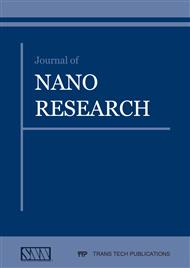[1]
S. Park, R. S. Ruoff, Chemical methods for the production of graphenes. Nat. Nanotechnol. 4 (2009) 217–224.
Google Scholar
[2]
A. K. Geim, Graphene: status and prospects. Science 324 (2009) 1530-1534.
Google Scholar
[3]
A. K. Geim, K. S. Novoselov, The rise of graphene. Nat. Mater. 6 (2007) 183-191.
Google Scholar
[4]
K. S. Novoselov, A. K. Geim, S. V. Morozov, et al. Electric field in atomically thin carbon films. Science 306 (2004) 666-669.
DOI: 10.1126/science.1102896
Google Scholar
[5]
V. Singh, D. Joung, L. Zhai, et al. Graphene based materials: past, present and future. Prog. Mater. Sci. 56 (2011) 1178-1271.
DOI: 10.1016/j.pmatsci.2011.03.003
Google Scholar
[6]
R. Verdejo, M. M. Bernal, L. J. Romasanta, et al. Graphene filled polymer nanocomposites. J. Mater. Chem. 21 (2011) 3301-3310.
DOI: 10.1039/c0jm02708a
Google Scholar
[7]
J. S. Arellano, Adsorption of Molecular Hydrogen in a Graphene-Carbon Nanotube System. J. Nano Res-Sw. 5 (2009) 201-211.
Google Scholar
[8]
K. S. Hu, D. D. Kulkarni, I. Choi, et al. Graphene-polymer nanocomposites for structural and functional applications, Prog. Polym. Sci. 39 (2014) 1934-(1972).
Google Scholar
[9]
J. Fu, F. Bernard, S. Multiscale modeling and mechanical properties of zigzag CNT and triple-layer graphene sheet based on Atomic Finite Element Method. J. Nano Res-Sw. 33 (2015) 92-105.
DOI: 10.4028/www.scientific.net/jnanor.33.92
Google Scholar
[10]
W. Chen, L. Yan, Preparation of graphene by a low-temperature thermal reduction at atmosphere pressure. Nanoscale 2 (2010) 559-563.
DOI: 10.1039/b9nr00191c
Google Scholar
[11]
J. Liu, Z. Wang, J. Chen, X. Wang, Nitrogen-Doped Carbon Nanotubes and Graphene Nanohybrid for Oxygen Reduction Reaction in Acidic, Alkaline and Neutral Solutions. J. Nano Res-Sw. 30 (2015)50-58.
DOI: 10.4028/www.scientific.net/jnanor.30.50
Google Scholar
[12]
Y, Geng, S. J. Wang, J. K. Kim, Preparation of graphite nanoplatelets and graphene sheets. J. Colloid. Interface. Sci. 336 (2009) 592-598.
DOI: 10.1016/j.jcis.2009.04.005
Google Scholar
[13]
J. W. S. Hummers, R. E. Offeman, Preparation of graphitic oxide. J. Am. Chem. Soc. 80 (1958) 1339-1339.
DOI: 10.1021/ja01539a017
Google Scholar
[14]
D. Li, M. B. Müller, S. Gilje, et al. Processable aqueous dispersions of graphene nanosheets. Nat. Nanotechnol. 3 (2008) 101-105.
Google Scholar
[15]
N. A. Kotov, Materials science: carbon sheet solutions. Nature 442 (2006) 254-255.
Google Scholar
[16]
M. Cano, U. Khan, T. Sainsbury, et al. Improving the mechanical properties of graphene oxide based materials by covalent attachment of polymer chains. Carbon 52 (2013) 363-371.
DOI: 10.1016/j.carbon.2012.09.046
Google Scholar
[17]
S. Villar-Rodil, J. I. Paredes, A. Martínez-Alonso, et al. Preparation of graphene dispersions and graphene-polymer composites in organic media. J. Mater. Chem. 19 (2009) 3591-3593.
DOI: 10.1039/b904935e
Google Scholar
[18]
Y. Liang, D. Wu, X. Feng, et al. Dispersion of graphene sheets in organic solvent supported by ionic interactions. Adv. Mater. 21 (2009) 1679-1683.
DOI: 10.1002/adma.200803160
Google Scholar
[19]
H. B. Lee, A. V. Raghu, K. S. Yoon, et al. Preparation and characterization of poly(ethylene oxide)/graphene nanocomposites from an aqueous medium. J. Macromol. Sci. Part B: Phys 49 (2010) 802-809.
DOI: 10.1080/00222341003603701
Google Scholar
[20]
M. Fang, K. Wang, H. Lu, et al. Single-layer graphene nanosheets with controlled grafting of polymer chains. J. Mater. Chem. 20 (2010) 1982-(1992).
DOI: 10.1039/b919078c
Google Scholar
[21]
A. Lorenzetti, M. Roso, A. Bruschetta, et al. Polyurethane-graphene nanocomposite foams with enhanced thermal insulating properties, Polym. Adv. Technol. 27 (2016) 303-307.
DOI: 10.1002/pat.3635
Google Scholar
[22]
J. Fu, P. Zong, L. Chen, et al. A Facile Approach to Covalently Functionalized Graphene Nanosheet Hybrids and Polymer Nanocomposites, Chem. Nanomat. 2 (2016) 830-839.
DOI: 10.1002/cnma.201600131
Google Scholar
[23]
D. Cai, J. Jin, K. Yusoh, et al. High performance polyurethane/ functionalized graphene nanocomposites with improved mechanical and thermal properties. Compos. Sci. Technol. 72 (2012) 702-707.
DOI: 10.1016/j.compscitech.2012.01.020
Google Scholar
[24]
J. L. Yan, G. Q. Qi, J. Cao, et al. Study on amino-functionalized graphene oxide/poly(methyl methacrylate) nanocomposites. Chem. Lett. 41 (2012) 683-685.
DOI: 10.1246/cl.2012.683
Google Scholar
[25]
K. P. Pramoda, H. Hussain, H. M. Koh, et al. Covalent bonded polymer–graphene nanocomposites. J. Polym. Sci. Part A: Polym. Chem. 48 (2010) 4262-4267.
DOI: 10.1002/pola.24212
Google Scholar
[26]
J. Yang, X. Yan, M. Wu, et al. Self-assembly between graphene sheets and cationic poly(methyl methacrylate) (PMMA) particles: preparation and characterization of PMMA/graphene composites. J. Nanopart. Res. 14 (2012) 1-9.
DOI: 10.1007/s11051-011-0717-0
Google Scholar
[27]
R. Moriche, S. G. Prolongo, M. Sánchez, et al. Morphological changes on graphene nanoplatelets induced during dispersion into an epoxy resin by different methods. Compos. Part B-Eng. 72 (2015) 199-205.
DOI: 10.1016/j.compositesb.2014.12.012
Google Scholar
[28]
J. M. Englert, P. Vecera, K. C. Knirsch, et al. Scanning-Raman-microscopy for the statistical analysis of covalently functionalized graphene. ACS Nano 7 (2013) 5472-5482.
DOI: 10.1021/nn401481h
Google Scholar
[29]
S. Eigler, C. Dotzer, A. Hirsch, Visualization of defect densities in reduced graphene oxide. Carbon 50 (2012) 3666-3673.
DOI: 10.1016/j.carbon.2012.03.039
Google Scholar
[30]
D. C. D. Nath, V. Sahajwalla, Application of fly ash as a catalyst for synthesis of carbon nanotube ribbons. J. Hazard Mater. 192 (2011) 691-697.
DOI: 10.1016/j.jhazmat.2011.05.072
Google Scholar


